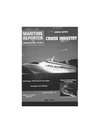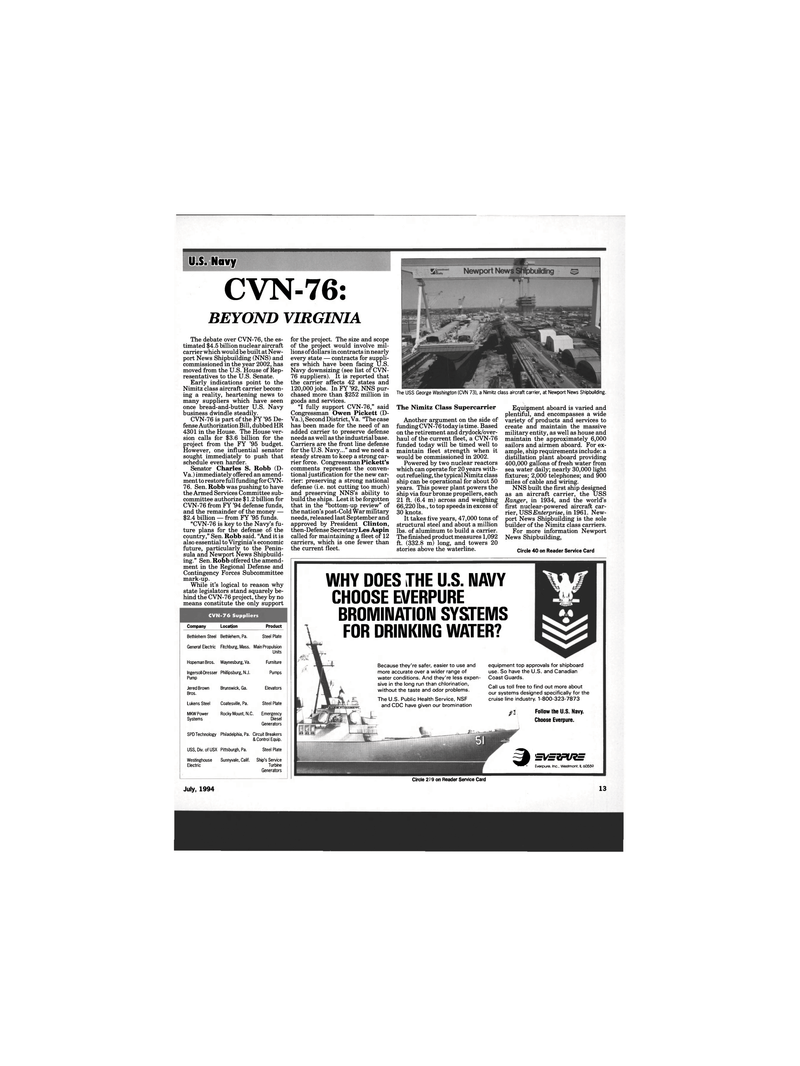
Page 11: of Maritime Reporter Magazine (July 1994)
Read this page in Pdf, Flash or Html5 edition of July 1994 Maritime Reporter Magazine
U.S. Navy
CVN-76:
BEYOND VIRGINIA
The USS George Washington (CVN 73), a Nimitz class aircraft carrier, at Newport News Shipbuilding.
The debate over CVN-76, the es- timated $4.5 billion nuclear aircraft carrier which would be built at New- port News Shipbuilding (NNS) and commissioned in the year 2002, has moved from the U.S. House of Rep- resentatives to the U.S. Senate.
Early indications point to the
Nimitz class aircraft carrier becom- ing a reality, heartening news to many suppliers which have seen once bread-and-butter U.S. Navy business dwindle steadily.
CVN-76 is part of the FY '95 De- fense Authorization Bill, dubbed HR 4301 in the House. The House ver- sion calls for $3.6 billion for the project from the FY '95 budget.
However, one influential senator sought immediately to push that schedule even harder.
Senator Charles S. Robb (D-
Va.) immediately offered an amend- ment to restore full funding for CVN- 76. Sen. Robb was pushing to have the Armed Services Committee sub- committee authorize $1.2 billion for
CVN-76 from FY '94 defense funds, and the remainder of the money — $2.4 billion — from FY '95 funds. "CVN-76 is key to the Navy's fu- ture plans for the defense of the country," Sen. Robb said. "And it is also essential to Virginia's economic future, particularly to the Penin- sula and Newport News Shipbuild- ing." Sen. Robb offered the amend- ment in the Regional Defense and
Contingency Forces Subcommittee mark-up.
While it's logical to reason why state legislators stand squarely be- hind the CVN-76 project, they by no means constitute the only support
CVN-76 Suppliers
Company Location Product
Bethlehem Steel Bethlehem, Pa. Steel Plate
General Electric Fitchburg, Mass. Main Propulsion
Units
Hopeman Bros. Waynesburg, Va. Furniture
Ingersoll-Dresser Phillipsburg, N.J. Pumps
Pump
Jered Brown Brunswick, Ga. Elevators
Bros.
Lukens Steel Coatesville, Pa. Steel Plate
MKW Power Rocky Mount, N.C. Emergency
Systems Diesel
Generators
SPD Technology Philadelphia, Pa. Circuit Breakers & Control Equip.
USS, Div. of USX Pittsburgh, Pa. Steel Plate
Westinghouse Sunnyvale, Calif. Ship's Service
Electric Turbin
Generators for the project. The size and scope of the project would involve mil- lions of dollars in contracts in nearly every state — contracts for suppli- ers which have been facing U.S.
Navy downsizing (see list of CVN- 76 suppliers). It is reported that the carrier affects 42 states and 120,000 jobs. In FY '92, NNS pur- chased more than $252 million in goods and services. "I fully support CVN-76," said
Congressman Owen Pickett (D-
Va.), Second District, Va. "The case has been made for the need of an added carrier to preserve defense needs as well as the industrial base.
Carriers are the front line defense for the U.S. Navy..." and we need a steady stream to keep a strong car- rier force. Congressman Pickett's comments represent the conven- tional justification for the new car- rier: preserving a strong national defense (i.e. not cutting too much) and preserving NNS's ability to build the ships. Lest it be forgotten that in the "bottom-up review" of the nation's post-Cold War military needs, released last September and approved by President Clinton, then-Defense Secretary Les Aspin called for maintaining a fleet of 12 carriers, which is one fewer than the current fleet.
The Nimitz Class Supercarrier
Another argument on the side of funding CVN-76 today is time. Based on the retirement and drydock/over- haul of the current fleet, a CVN-76 funded today will be timed well to maintain fleet strength when it would be commissioned in 2002.
Powered by two nuclear reactors which can operate for 20 years with- out refueling, the typical Nimitz class ship can be operational for about 50 years. This power plant powers the ship via four bronze propellers, each 21 ft. (6.4 m) across and weighing 66,220 lbs., to top speeds in excess of 30 knots.
It takes five years, 47,000 tons of structural steel and about a million lbs. of aluminum to build a carrier.
The finished product measures 1,092 ft. (332.8 m) long, and towers 20 stories above the waterline.
Equipment aboard is varied and plentiful, and encompasses a wide variety of products and services to create and maintain the massive military entity, as well as house and maintain the approximately 6,000 sailors and airmen aboard. For ex- ample, ship requirements include: a distillation plant aboard providing 400,000 gallons of fresh water from sea water daily; nearly 30,000 light fixtures; 2,000 telephones; and 900 miles of cable and wiring.
NNS built the first ship designed as an aircraft carrier, the USS
Ranger, in 1934, and the world's first nuclear-powered aircraft car- rier, USS Enterprise, in 1961. New- port News Shipbuilding is the sole builder of the Nimitz class carriers.
For more information Newport
News Shipbuilding,
Circle 40 on Reader Service Card
WHY DOES THE U.S. NAVY
CHOOSE EVERPURE
BR0MINATI0N SYSTEMS
FOR DRINKING WATER?
Because they're safer, easier to use and more accurate over a wider range of water conditions. And they're less expen- sive in the long run than chlorination, without the taste and odor problems.
The U.S. Public Health Service, NSF and CDC have given our bromination equipment top approvals for shipboard use. So have the U.S. and Canadian
Coast Guards.
Call us toll free to find out more about our systems designed specifically for the cruise line industry. 1-800-323-7873 0, Follow the U.S. Navy.
Choose Everpure. ^ EVEWZE ^^^^ Everpure, Inc., Westmont, IL 60559
Circle 269 on Reader Service Card
July, 1994 13

 10
10

 12
12
